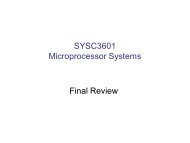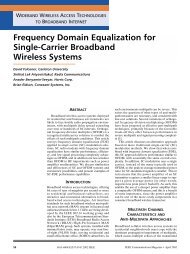Image Reconstruction for 3D Lung Imaging - Department of Systems ...
Image Reconstruction for 3D Lung Imaging - Department of Systems ...
Image Reconstruction for 3D Lung Imaging - Department of Systems ...
Create successful ePaper yourself
Turn your PDF publications into a flip-book with our unique Google optimized e-Paper software.
where ˆx(i) is the prior value <strong>of</strong> node i, r is the radius <strong>of</strong> the neighbourhood, d is distance<br />
between node i and node n. Ωi represents the radial neighbourhood <strong>of</strong> node i; members<br />
<strong>of</strong> the set Ω are nodes that are located within a distance r <strong>of</strong> node i. n ∈ Ωi means that<br />
n belongs to the radial neighbourhood <strong>of</strong> node i. r/dn is a weighing <strong>of</strong> the nodal value.<br />
This <strong>for</strong>mulation <strong>for</strong> a Laplacian filter is mesh size independent which is different from the<br />
discrete Laplacian filters used in [93] and [25].<br />
5.2.7 Smoothing Mask Filter<br />
In addition to the filters used directly in the regularized inverse it is also possible to apply<br />
a spatial smoothing filter, RLP, to the nodal solutions <strong>of</strong> equation 5.6 by multiplying the<br />
solution with the low pass filter. This can be treated as a post processing step that increases<br />
the signal-to-noise ratio (SNR) <strong>of</strong> the solution. This filter is implemented through matrix<br />
multiplication as ˆx ′ = R k LP<br />
ˆx. The exponent k indicates that this filter can be applied<br />
multiple times. In this paper we use k = 1 but other values are possible. RLP calculates a<br />
filtered value <strong>for</strong> node i as follows<br />
ˆx ′ (i) = �<br />
ˆx(n)/�Ωi� (5.13)<br />
n∈Ωi<br />
where n ∈ Ωi means that n is a member <strong>of</strong> the radial neighbourhood <strong>of</strong> node i including<br />
node i and �Ωi� means the number <strong>of</strong> members <strong>of</strong> Ωi. We incorporate RLP into equation<br />
5.6 be<strong>for</strong>e hyperparameter selection. Thus equation 5.6 with W = I is restated as<br />
ˆx = R k LP (HT H + λ 2 R) −1 H T z (5.14)<br />
with hyperparameter selected using the BestRes algorithm described in chapter 4. The<br />
complete algorithm can then be per<strong>for</strong>med with any z.<br />
5.2.8 Evaluation Procedure<br />
In order to evaluate the per<strong>for</strong>mance <strong>of</strong> this algorithm, the following test procedures were<br />
conducted.<br />
1. Initially we validate the per<strong>for</strong>mance <strong>of</strong> the new algorithm by comparing its per<strong>for</strong>mance<br />
to the traditional algorithm <strong>for</strong> 2D reconstructions using tank data <strong>of</strong> a<br />
pseudo-impulse phantom. Comparisons are made between the nodal and elemental<br />
Jacobians using the RTik, Rdiag, RHPF and RLap priors.<br />
2. We validate the 2D hyperparameter selection method, BestRes, (chapter 4) <strong>for</strong> <strong>3D</strong><br />
reconstructions.<br />
3. We quantify the per<strong>for</strong>mance <strong>of</strong> the <strong>3D</strong> nodal algorithm using the RTik, Rdiag, RHPF<br />
and RLap priors, with two sets <strong>of</strong> simulated impulse phantom data. Both sets <strong>of</strong> simulated<br />
data were created by moving an impulse contrast through 28 vertical positions<br />
<strong>of</strong> a 28 layer, 86016 element, 15805 node FEM that is similar to, but denser than<br />
the FEM <strong>of</strong> figure 5.1(b). <strong>Reconstruction</strong>s are made using the 21504 element mesh<br />
<strong>of</strong> figure 5.1(b) One set <strong>of</strong> data had the impulse contrasts located at the axial center<br />
(r = 0), the second set <strong>of</strong> data had the contrasts located halfway between the axial<br />
center and the tank boundary (r/2).<br />
4. Finally we validate the Nodal Jacobian algorithm with some lab data <strong>of</strong> human lungs.<br />
69





